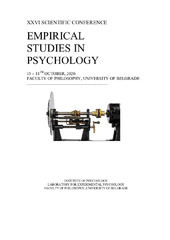Prikaz osnovnih podataka o dokumentu
Motivation for teaching among different groups of preservice teachers
| dc.creator | Simić, Nataša | |
| dc.creator | Marušić Jablanović, Milica | |
| dc.creator | Grbić, Sanja | |
| dc.date.accessioned | 2023-05-15T13:11:10Z | |
| dc.date.available | 2023-05-15T13:11:10Z | |
| dc.date.issued | 2020 | |
| dc.identifier.isbn | 978-86-6427-163-9 | |
| dc.identifier.uri | http://reff.f.bg.ac.rs/handle/123456789/4461 | |
| dc.description.abstract | Despite the unfavourable status of the teaching profession in Serbia, the number of studies investigating teachers’ motivation for teaching has remained relatively low. The goal of this study was to explore the motivations for a teaching profession and to determine if there were differences in motivation depending on the teaching program and disciplines preservice teachers studied. Participants were 433 preservice teachers from four Serbian state universities (Mage= 22.6, SD = 2.32). There were 25.2% participants from teacher training faculty (prospective class teachers), 30.3% from Science and Engineering faculties and 44.5% from Social science and Humanities faculties (prospective subject teachers). Relying on the FIT-Choice model, 42-item Factors influencing choice of a teaching career scale was applied, which consists of 13 motivation constructs/ reasons for choosing a teaching career. The highest rated reasons for choosing a teaching career were: Intrinsic value (M = 6.14, SD = 1.08, range 1–7), Shape future of children (M = 5.72, SD = 1.34), Perceived teaching abilities (M = 5.43, SD = 1.16) and Work with children (M = 5.41, SD = 1.56), while choosing teaching as a Fallback career was the lowest ranked factor (M = 1.78, SD = 1.16). ANOVA with the type of faculty being independent variable pointed to significant differences on: Time for family (F(2, 430) = 8.148, p < .001, ηp2=.037), Enhance social equity (F(2, 430) = 6.706, p < .001, ηp2 = .030), Social influences (F(2, 430) = 4.502, p < .005, ηp2=.021), Work with children (F(2, 430) = 10.226, p < .001, ηp2=.045), and Shape future of children (F(2, 430) = 4.250, p < .005, ηp2=.019). Scheffe’s post hoc test revealed that the prospective Social science and Humanities teachers scored lower on the factor Time for family than both prospective class and Science and Engineering teachers. Prospective class teachers scored higher on Enhance social equity and Work with children than prospective subject teachers. Prospective class teachers are more strongly motivated by the factor Shape future of children than the prospective Science and Engineering teachers, and more motivated by Social influences (those of the family and friends) than the Social science and Humanities teachers. Results are discussed in the light of broader socioeconomic situation, societal values and the preservice education characteristics | sr |
| dc.language.iso | en | sr |
| dc.publisher | Belgrade: Institute of Psychology, Laboratory for Experimental Psychology, Faculty of Philosophy, University of Belgrade | sr |
| dc.rights | openAccess | sr |
| dc.rights.uri | https://creativecommons.org/licenses/by/4.0/ | |
| dc.source | Book of abstracts, XXVI Scientific Conference “Empirical Studies in Psychology”, Belgrade | sr |
| dc.subject | motivation | sr |
| dc.subject | teaching profession | sr |
| dc.subject | preservice teachers | sr |
| dc.subject | FIT-Choice | sr |
| dc.title | Motivation for teaching among different groups of preservice teachers | sr |
| dc.type | conferenceObject | sr |
| dc.rights.license | BY | sr |
| dc.rights.holder | Authors | sr |
| dc.citation.spage | 69 | |
| dc.identifier.fulltext | http://reff.f.bg.ac.rs/bitstream/id/10987/2020_FIT_Choice_EIP_abs_M34.pdf | |
| dc.identifier.rcub | https://hdl.handle.net/21.15107/rcub_reff_4461 | |
| dc.type.version | publishedVersion | sr |

